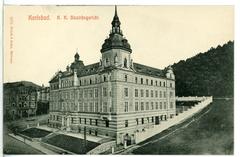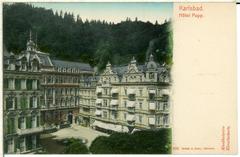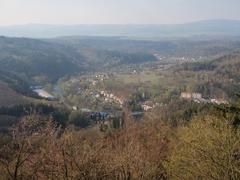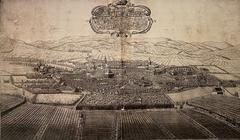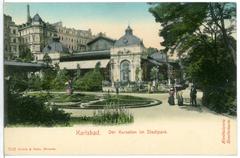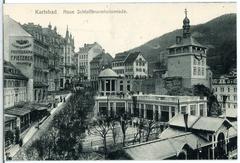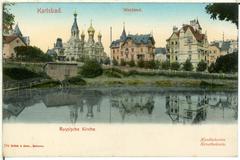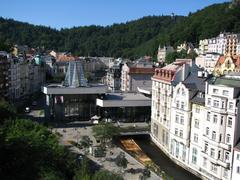Visiting Návštěvnické Centrum Moser: Hours, Tickets, and Tips
Date: 23/07/2024
Introduction
Nestled in the picturesque spa town of Karlovy Vary, the Návštěvnické Centrum Moser offers visitors an immersive journey into the world of fine glassmaking. Established in 1857 by Ludwig Moser, Moser Glassworks has grown to become one of the most prestigious names in the glass industry. This guide provides comprehensive information about visiting the Návštěvnické Centrum Moser, including historical insights, visiting hours, ticket prices, and travel tips. Understanding the rich history and cultural significance of Moser Glassworks not only enhances the visitor experience but also highlights why it’s a must-visit destination in Karlovy Vary (Visit Moser).
Table of Contents
- [Introduction](#introductionintroduction)
- [Exploring Moser Glassworks: History, Visiting Hours, and Tickets](#exploring-moser-glassworks-history-visiting-hours-and-ticketsexploring-moser-glassworks)
- [Founding and Early Years](#founding-and-early-yearsfounding-and-early-years)
- [Expansion and Innovation](#expansion-and-innovationexpansion-and-innovation)
- [The Art Nouveau Influence](#the-art-nouveau-influencethe-art-nouveau-influence)
- [The Interwar Period and World War II](#the-interwar-period-and-world-war-iithe-interwar-period-and-world-war-ii)
- [Post-War Revival and Modern Era](#post-war-revival-and-modern-erapost-war-revival-and-modern-era)
- [Cultural and Historical Significance](#cultural-and-historical-significancecultural-and-historical-significance)
- [Visitor Experience at Návštěvnické Centrum Moser](#visitor-experience-at-návštěvnické-centrum-moservisitor-experience)
- [Visiting Hours and Tickets](#visiting-hours-and-ticketsvisiting-hours-and-tickets)
- [Travel Tips and Nearby Attractions](#travel-tips-and-nearby-attractionstravel-tips-and-nearby-attractions)
- [FAQ](#faqfaq)
- [Conclusion](#conclusionconclusion)
- [References](#referencesreferences)
Exploring Moser Glassworks: History, Visiting Hours, and Tickets
Founding and Early Years
Moser Glassworks, established in 1857 by Ludwig Moser in Karlovy Vary, Czech Republic, has a storied history that intertwines with the cultural and industrial development of the region. Ludwig Moser, a skilled engraver and businessman, initially opened a glass engraving workshop. His early works were characterized by intricate designs and high-quality craftsmanship, which quickly garnered attention and acclaim. By 1873, Moser had expanded his operations to include glass production, establishing a full-fledged glassworks facility (Moser Glass).
Expansion and Innovation
The late 19th and early 20th centuries were periods of significant growth and innovation for Moser Glassworks. Ludwig Moser’s commitment to quality and artistic excellence led to numerous awards and recognitions at international exhibitions, including the 1873 Vienna World’s Fair and the 1900 Paris Exposition Universelle. These accolades helped cement Moser’s reputation as a premier glass manufacturer.
During this period, Moser introduced several groundbreaking techniques and designs. One notable innovation was the development of lead-free crystal, which became a hallmark of Moser glass. This innovation not only enhanced the aesthetic qualities of the glass but also made it more durable and environmentally friendly (Glass Encyclopedia).
The Art Nouveau Influence
The turn of the 20th century saw Moser Glassworks embracing the Art Nouveau movement, which emphasized organic forms and intricate, flowing designs. This period marked a high point in Moser’s artistic achievements, with the glassworks producing some of its most iconic pieces. The influence of Art Nouveau is evident in the delicate floral motifs and sinuous lines that characterize Moser glass from this era.
Moser’s collaboration with renowned artists and designers further elevated its status. The glassworks worked with artists such as Alfons Mucha and Otto Prutscher, whose designs brought a new level of sophistication and artistic expression to Moser’s creations (Art Nouveau World).
The Interwar Period and World War II
The interwar period and World War II presented significant challenges for Moser Glassworks. The economic turmoil of the 1920s and 1930s, coupled with the political instability in Europe, affected the glass industry as a whole. Despite these challenges, Moser continued to innovate and produce high-quality glassware.
During World War II, the glassworks faced further difficulties, including material shortages and disruptions in production. However, Moser’s resilience and commitment to craftsmanship allowed it to survive these tumultuous times. The post-war period saw a resurgence in demand for luxury glassware, and Moser was well-positioned to capitalize on this renewed interest (Moser History).
Post-War Revival and Modern Era
The latter half of the 20th century marked a period of revival and modernization for Moser Glassworks. The company invested in new technologies and expanded its product range to include contemporary designs while maintaining its commitment to traditional craftsmanship. This blend of innovation and tradition has allowed Moser to remain relevant in an ever-changing market.
In recent years, Moser has continued to collaborate with contemporary artists and designers, ensuring that its products remain at the forefront of artistic and technical excellence. The glassworks has also embraced sustainable practices, further enhancing its reputation as a leader in the glass industry (Moser Today).
Cultural and Historical Significance
Moser Glassworks holds a special place in the cultural and historical landscape of Karlovy Vary and the Czech Republic. Its products are not only prized for their beauty and craftsmanship but also serve as symbols of the region’s rich artistic heritage. Moser glass can be found in prestigious collections and institutions around the world, including the British Museum and the Metropolitan Museum of Art (British Museum).
The glassworks’ commitment to preserving traditional techniques while embracing innovation has made it a model for other manufacturers. Moser’s influence extends beyond the realm of glassmaking, contributing to the broader cultural and economic development of the region.
Visitor Experience at Návštěvnické Centrum Moser
Visiting Hours and Tickets
The Návštěvnické Centrum Moser is open daily from 9:00 AM to 5:00 PM. Tickets can be purchased on-site or online through the official website. Admission prices are as follows:
- Adults: 150 CZK
- Students and Seniors: 100 CZK
- Children (under 12): Free
Travel Tips and Nearby Attractions
Karlovy Vary is a picturesque spa town known for its hot springs and stunning architecture. Visitors to Moser Glassworks can also explore nearby attractions such as the Mill Colonnade, the Church of St. Mary Magdalene, and the Jan Becher Museum. Convenient public transportation and ample parking make it easy to navigate the town.
FAQ
What are the visiting hours for Moser Glassworks? The Návštěvnické Centrum Moser is open daily from 9:00 AM to 5:00 PM.
How much are tickets for Moser Glassworks?
- Adults: 150 CZK
- Students and Seniors: 100 CZK
- Children (under 12): Free
Are there guided tours available? Yes, guided tours are available and provide insights into the glassmaking process and history of Moser Glassworks.
What are some nearby attractions? Nearby attractions include the Mill Colonnade, the Church of St. Mary Magdalene, and the Jan Becher Museum.
Conclusion
The history of Moser Glassworks is a testament to the enduring appeal of high-quality craftsmanship and artistic innovation. From its humble beginnings in 1857 to its current status as a global leader in luxury glassware, Moser has consistently pushed the boundaries of what is possible in glassmaking. Visitors to the Návštěvnické Centrum Moser can immerse themselves in this rich history, gaining a deeper appreciation for the artistry and skill that define Moser glass. Whether you’re a glass art enthusiast or a casual visitor, the Návštěvnické Centrum Moser promises a memorable and educational experience (Moser Glassworks History, Glass Encyclopedia).



